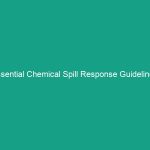Must-Know Alarm Safety Tips: Avoid Critical Risks in HSE Practices
Introduction
Good morning team,
Today, we’re going to discuss a crucial aspect of Workplace Safety: alarm Safety. Understanding how to effectively manage alarms in our Health, Safety, and Environment (HSE) practices can significantly reduce risks and protect all of us on the job. Alarms are designed to alert us to potential Hazards, but without proper knowledge and Procedures, they can also lead to confusion and complacency.
Let’s dive into why alarm safety is so important and how we can enhance our practices to ensure a safe working environment for everyone.
Understanding Alarm Safety
Alarm safety refers to the protocols and practices surrounding the use of alarms in the workplace, particularly in emergency situations. These alarms are critical for alerting employees to dangers such as fire, chemical spills, or other life-threatening situations.
Ignoring alarm protocols can lead to severe consequences, including injuries or fatalities. A common misconception is that alarms are only meant for emergencies; however, they play a vital role in our daily operations by alerting us to potential Hazards before they escalate.
Key Hazards, Risks, and Safety Considerations
When it comes to alarm safety, there are several hazards and risks that we need to be aware of:
- False Alarms: Frequent false alarms can lead to alarm fatigue, where employees begin to ignore alarms, potentially putting them in danger.
- Delayed Responses: If employees do not know how to respond quickly and effectively to alarms, it can lead to critical delays during emergencies.
- Inadequate Training: Without proper training on alarm systems, employees may not understand the significance of the alarms or the correct procedures to follow.
Real-world consequences of ignoring alarm safety can be devastating. For example, in a manufacturing facility, a malfunctioning fire alarm could lead to a disaster if employees are not trained on Evacuation Procedures. We must take alarm safety seriously to protect ourselves and our coworkers.
Best Practices, Procedures, & Actionable Advice
Here are some essential alarm safety tips that every employee should follow:
1. Understand Alarm Types
Familiarize yourself with different types of alarms in your workplace (e.g., fire alarms, gas leak alarms, etc.) and what each alarm signifies. This understanding is crucial for effective response.
2. Regular Drills and Training
Participate in regular fire drills and training sessions. Practicing emergency procedures helps reinforce the appropriate actions to take when an alarm sounds.
3. Know the Evacuation Routes
Be aware of the nearest exits and evacuation routes in case of an emergency. Knowing how to exit quickly can save lives.
4. Report Malfunctions Immediately
If you notice a malfunctioning alarm, report it to your supervisor immediately. Do not assume someone else will take care of it.
5. Stay Calm and Follow Protocols
In the event of an alarm, stay calm and follow the established protocols. Panic can lead to poor decision-making.
For example, during a recent fire drill at our facility, an employee hesitated at a malfunctioning alarm, thinking it was another false alarm. This caused unnecessary delays and confusion. Let’s ensure we all respond promptly and correctly in such situations.
Regulations, Standards, and Compliance
Compliance with safety Regulations is not just a requirement; it is essential for our safety. The Occupational Safety and Health Administration (OSHA) mandates that workplaces maintain effective emergency alarm systems. Additionally, adhering to ISO Standards related to safety management can greatly enhance our alarm systems’ reliability.
Understanding these regulations helps us appreciate the importance of alarm safety and the role it plays in protecting our health and safety. Compliance is critical for preventing accidents and ensuring that we all go home safely at the end of the day.
Employee Engagement & Discussion
Let’s take a moment to reflect on our experiences. What safety challenges have you encountered related to alarms? Have you ever felt unsure about how to respond during an alarm? Your insights can help us improve our safety practices and ensure we are all prepared in case of an emergency.
Conclusion & Key Takeaways
In conclusion, alarm safety is a vital component of our workplace HSE practices. By understanding alarm systems, recognizing the risks involved, and following Best Practices, we can significantly reduce the chances of accidents and ensure a safer work environment.
Remember, your safety and the safety of your coworkers depend on our collective commitment to alarm safety. Thank you for your attention and for your ongoing commitment to prioritizing safety in our workplace. Together, we can create a secure and healthy environment for everyone.


